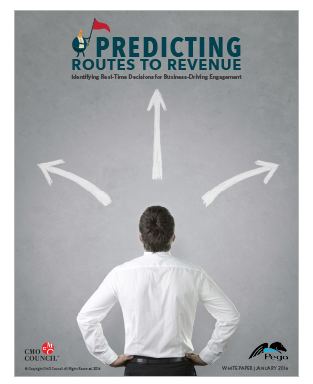 MO Council Study Finds Marketers Struggling to Personalize, Create
MO Council Study Finds Marketers Struggling to Personalize, Create
Real-Time Interactions and Shape Customer Purchasing Journey and Outcomes
While there is an over-abundance of consumer data and analytics, marketers have yet to master what meteorologists and economists do best: funnel this multiplicity of data into actionable insights to reliably anticipate and predict what’s ahead and then prepare for it.
According to a new study from the CMO Council—entitled “Predicting Routes to Revenue”—only 5 percent of marketers say they have mastered the ability to adapt and predict the customer journey and what actions will derive maximum value. The study is based on insights from more than 150 senior marketing executives surveyed primarily across North America and Europe during the fourth quarter of 2015 and was conducted in partnership with Pegasystems, a provider of strategic business applications.
Marketers looking to deliver exceptional customer experiences are increasingly turning to personalization as the key driver to maximize customer value. But this will require redefining data’s value and primary role, moving away from using data as a vehicle to calculate past performance metrics and into a critical tool to uncover new, real-time insights about customer behavior—including how customers react to different trends, news, offers, deals, product promises, promotional prompts, recommendations, social commentary and personalized messages.
While 23 percent of marketers are able to develop predictive insights into broad customer trends, another 20 percent feel they are only able to predict the next best action and struggle to move beyond that first step. Delivering on brand promises is another area that appears to be lacking for marketers, as two-thirds of respondents revealed their success in this area is hit-or-miss, with 14 percent admitting they were completely missing the mark.
The results indicate that a key contributor to this lack of advancing analytics is a fundamental misalignment of data sources as marketers continue to struggle with aggregation, alignment and analysis of data across disparate sources. Forty-eight (48) percent indicate that data is collected and analyzed but remains separate and is not well aligned. Only 3 percent say their current data sources are integrated and totally aligned, delivering a comprehensive 360-degree view of the customer.
“Marketers have the right intentions, working to deliver rich, personalized and relevant engagements across an increasing number of channels, but there are still a number of roadblocks preventing us from maximizing efforts in this area,” noted Liz Miller, Senior Vice President of Marketing with the CMO Council. “Personalization isn’t a question of using a customer’s name in an email subject line. Personalizing the customer experience demands that we harness the data that is collected across the organization and immediately transform that into something that is actionable and resonates with the customer and their preferences. If personalization remains a way to add a few interesting indicators to a momentary campaign, we will fail in fully optimizing the revenue potential of each individual customer.”
One clear challenge is the multitude of channels through which marketers can listen to and engage with customers. The top sources of insights into customers, prospects and markets include visits to the corporate website (74 percent), sales data and CRM-based customer records (68 percent), and customer satisfaction surveys (57 percent), to provide a partial list.
“The sheer volume of customer data available to marketers today is both a blessing and a curse,” said Robert Tas, CMO of Pegasystems. “As customer expectations rise when they reveal more about themselves, most organizations aren’t equipped to reciprocate by providing a better, more personalized experience. By deploying real-time analytics to turn this data into actionable insights, organizations can predict customer needs and quickly adjust as those needs change to provide superior experiences at every interaction.”
Marketers have a clear idea of what moves need to be made in the year ahead to make real strides in making personalization a reality for their customer experiences. First and foremost, marketers are looking to connect fragmented campaigns into a complete customer journey that is reflected and embraced by the entire organization. Other areas of priority include:
Adding more personalized experiences that are based on customer data (59 percent)
Expanding engagement channels to better meet customers where they want to engage (54 percent)
More completely aligning front-line resources (sales, service, in-store, support) to create exceptional experiences in any channel (45 percent)
Delivering real-time, relevant offers to optimize revenue (41 percent)
Detailed charts and findings are included in a 30-page complimentary white paper, which is now available for download from the CMO Council. Fifty-six (56) percent of respondents hail from organizations with more than $1 billion (USD) in revenue, and 29 percent hold titles of CMO or Senior Vice President of Marketing.


